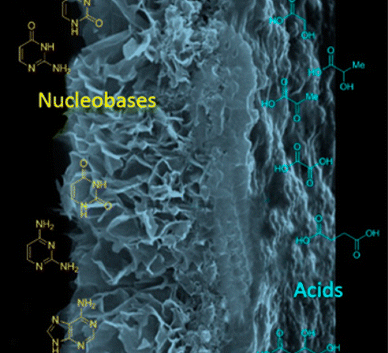Saladino, R.; Botta, G.; Bizzarri, B. M.; Di Mauro, E.; Garcia Ruiz, J. M., Biochemistry 2016, 55 (19), 2806-2811.
The pathway from simple abiotically made organic compounds to the molecular bricks of life, as we know it, is unknown. The most efficient geological abiotic route to organic compounds results from the aqueous dissolution of olivine, a reaction known as serpentinization (Sleep, N.H., et al. (2004) Proc. Natl. Acad. Sci. USA 101, 12818–12822). In addition to molecular hydrogen and a reducing environment, serpentinization reactions lead to high-pH alkaline brines that can become easily enriched in silica. Under these chemical conditions, the formation of self-assembled nanocrystalline mineral composites, namely silica/carbonate biomorphs and metal silicate hydrate (MSH) tubular membranes (silica gardens), is unavoidable (Kellermeier, M., et al. In Methods in Enzymology, Research Methods in Biomineralization Science (De Yoreo, J., Ed.) Vol. 532, pp 225–256, Academic Press, Burlington, MA). The osmotically driven membranous structures have remarkable catalytic properties that could be operating in the reducing organic-rich chemical pot in which they form. Among one-carbon compounds, formamide (NH2CHO) has been shown to trigger the formation of complex prebiotic molecules under mineral-driven catalytic conditions (Saladino, R., et al. (2001) Biorganic & Medicinal Chemistry, 9, 1249–1253), proton irradiation (Saladino, R., et al. (2015) Proc. Natl. Acad. Sci. USA, 112, 2746–2755), and laser-induced dielectric breakdown (Ferus, M., et al. (2015) Proc Natl Acad Sci USA, 112, 657–662). Here, we show that MSH membranes are catalysts for the condensation of NH2CHO, yielding prebiotically relevant compounds, including carboxylic acids, amino acids, and nucleobases. Membranes formed by the reaction of alkaline (pH 12) sodium silicate solutions with MgSO4 and Fe2(SO4)3·9H2O show the highest efficiency, while reactions with CuCl2·2H2O, ZnCl2, FeCl2·4H2O, and MnCl2·4H2O showed lower reactivities. The collections of compounds forming inside and outside the tubular membrane are clearly specific, demonstrating that the mineral self-assembled membranes at the same time create space compartmentalization and selective catalysis of the synthesis of relevant compounds. Rather than requiring odd local conditions, the prebiotic organic chemistry scenario for the origin of life appears to be common at a universal scale and, most probably, earlier than ever thought for our planet.


